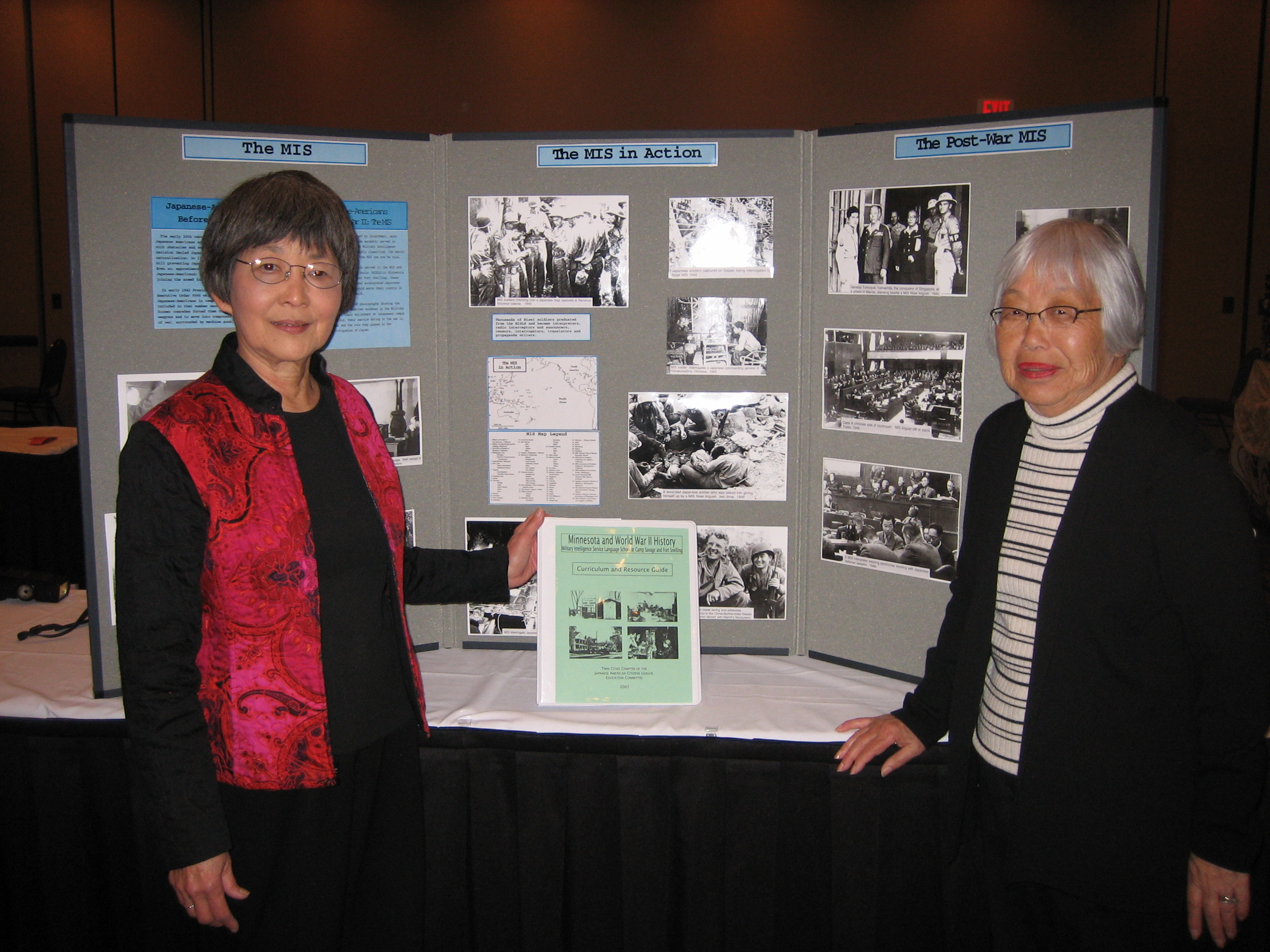This article was originally published in the March 30, 2007, issue of the Asian American Press.
By Cheryl Hirata-Dulas
Photo: Lil Grothe (left) and Lucy Kirihara displaying the Twin Cities JACL’s new MIS Curriculum Guide at the 2007 Great Lakes Regional social studies conference. (Photo by Cheryl Hirata-Dulas)
The Twin Cities Japanese American Citizens League(JACL) Education Committee unveiled its newly published curriculum guide on the Military Intelligence Service (MIS) at Great Lakes Conference ’07, a seven-state regional meeting of social studies teachers, hosted by the Minnesota Council on the Social Studies at Mystic Lake on March 8-9, 2007.
Included in the materials are biographies of local Japanese American World War II MIS veterans. Harry Umeda was in the first MIS class at Camp Savage in May 1942, and recalled the sparse quarters and initially having to study on the floor. After training, he was assigned to the Central Japanese Prisoner of War (POW) Compound in New Guinea, where he interrogated Japanese POWs for combat and strategic intelligence.
Toshio William Abe was also in the first graduating class at Camp Savage, and was sent to the China-Burma-India theater as a replacement for Merrill’s Marauders, where he served in continuous combat for eight months. He was on the front lines fighting as an infantryman, and translated captured documents and interrogated Japanese POWs there.
The other local MIS veterans highlighted are George Suzuki, Edwin (Bud) Nakasone and Bill Doi.
The project was prompted because the Minnesota Department of Education’s Academic Standards in History and Social Studies, approved in 2004, includes “Fort Snelling language school” as one of the examples to be taught under Minnesota and World War II History in grades 4-8.
The U.S. Army’s Military Intelligence Service (MIS) program was established in November 1941, a few weeks before Pearl Harbor, at the Presidio of San Francisco. In 1942, the order to exclude Japanese Americans from the west coast necessitated a move inland. While most governors were against having the MIS program moved to their states, Gov. Harold Stassen felt that the people of Minnesota could provide a friendly and accepting atmosphere to the Japanese American soldiers. The MIS program was moved to Camp Savage in May 1942, and later to larger facilities at Fort Snelling from August 1944 to June 1946.
The highly classified MIS program has been called “America’s secret weapon in the war against Japan.” Six thousand soldiers, mostly second-generation Americans of Japanese ancestry (Nisei), were given intense and accelerated training in the Japanese language.
Shipped overseas in small teams, the MIS soldiers accompanied American and Allied combat troops in every major landing in the Pacific. Their Japanese language skills enabled them to provide the American and Allied forces with critical information about the Japanese military tactical and strategic plans. After the war, MIS soldiers acted as interpreters at the war crimes trials, and served under General Douglas MacArthur’s occupation force in Japan.
According to General Charles Willoughby, Chief of Staff for Military Intelligence for General MacArthur, “the Nisei shortened the Pacific war by two years, and saved probably a million American lives and saved probably billions of dollars.”
A historical marker placed in 1995 by the Savage Chamber of Commerce at Highway 13 near Xenwood Avenue in Savage, identifies the site of Camp Savage and describes the role of the MIS during World War II.
The MIS soldiers played such an instrumental role during World War II, however, it is only fairly recently that their efforts have come to public attention.
“We are happy that government documents have been declassified and that the experiences of the MIS soldiers are being recognized and taught to students,” stated Sally Sudo, chair of the Twin Cities JACL Education Committee.
The MIS curriculum guide is available to educators for no charge through generous support from the family of the late Toshio William Abe and from George Suzuki. Lesson plans and learning activities are included that incorporate important aspects of the MIS, such as training at Camp Savage and Fort Snelling, interrogating Japanese prisoners of war, and translating the Japanese language.

